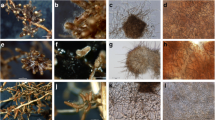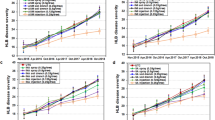Abstract
Huanglongbing (HLB), the most important citrus disease worldwide, is associated with bacteria transmitted by the Asian citrus psyllid (ACP) preferably through new shoots present in the canopy. In a commercial citrus plant, the vegetative growth of the scion is influenced by the rootstock variety in which it is grafted. Although all commercial citrus varieties planted in recent years are susceptible to HLB, the dynamics of the rootstock in grafted plant could influence the progress of HLB, whether at the plant or grove scale. In this work, HLB incidence in ‘Valencia’ sweet orange grafted onto 16 rootstocks and its relationship to the tree canopy volume and flushing dynamics were evaluated in a field trial under ACP control. The experiment was conducted under rainfed conditions in Bebedouro, state of São Paulo, Brazil, from 2011 to 2019. ‘Flying Dragon’ trifoliate orange known for its dwarfing characteristics was used as the rootstock. A reduction in canopy volume by 77% at 8 years of age were observed compared to the most vigorous rootstocks. The frequency of flush shoots of ‘Valencia’ sweet orange was not influenced by the rootstock, but the abundance of flush shoots was lower on three semi-dwarfing rootstocks and as well as ‘Flying Dragon’. Although HLB incidence on ‘Flying Dragon’ was lower than on ‘Rangpur’ lime and other three semi-standard rootstocks (trees with canopy volume between 51 and 75% of the ‘Rangpur’ lime canopy volume), all other combinations had similar HLB disease progress regardless of the canopy volume and flushing dynamics. Moreover, under field conditions, variations on the cumulative HLB incidence greater than 26% were necessary to significantly separate rootstocks. Therefore, the results suggest that true dwarfing rootstocks have potential to integrate the management program for HLB and that mechanisms in addition to tree vigor appear to be involved in the host–vector relationship.


Similar content being viewed by others
References
Abdullah TL, Shokrollah H, Sijam K, Abdullah SNA (2009) Control of Huanglongbing (HLB) disease with reference to its occurrence in Malaysia. African Journal of Biotechnology 8:4007–4015
Albrecht U, Bowman KD (2012) Tolerance of trifoliate citrus rootstock hybrids to Candidatus Liberibacter asiaticus. Scientia Horticulturae 147:71–80
Albrecht U, Bowman KD (2019) Reciprocal influence of rootstocks and scion citrus cultivars challenged with Ca. Liberibacter asiaticus. Scientia Horticulturae 254:133–142
Barbosa JC, Maldonado Jr W (2010) AgroEstat—sistema para análises de ensaios agronômicos, versão 1.0
Bassanezi RB, Montesino LH, Gasparoto MCG, Bergamin Filho A, Amorim L (2011) Yield loss caused by Huanglongbing in different sweet orange cultivars in São Paulo, Brazil. European Journal of Plant Pathology 130:577–586
Boava LP, Sagawa CHD, Cristofani-Yaly M, Machado MA (2014) Incidence of ‘Candidatus Liberibacter asiaticus’ infected plants among citrandarins as rootstock and scion under field conditions. Phytopathology 105:518–524
Boscariol-Camargo RL, Cristofani-Yaly AM, Coletta-Filho HD, Machado MA (2010) Avaliação de diferentes genótipos de citros à infecção por Candidatus Liberibacter asiaticus. Citrus Research & Technology 31:85–90
Bové JM (2006) Huanglongbing: a destructive, newly-emerging, century-old disease of citrus. Journal of Plant Pathology 88:7–37
Bowman KD, McCollum G (2015) Five new citrus rootstocks with improved tolerance to Huanglongbing. HortScience 50:1731–1734
Bowman KD, McCollum G, Albrecht U (2016) Performance of ‘Valencia’ orange (Citrus sinensis [L.] Osbeck) on 17 rootstocks in a trial severely affected by Huanglongbing. Scientia Horticulturae 201:355–361
Campbell CL, Madden LV (1990) Introduction to plant disease epidemiology. Wiley, New York
Cantuarias-Avilés T, de Assis Alves Mourão Filho F, Stuchi ES, Silva SR, Espinoza-Nuñes E (2011) Horticultural performance of ‘Folha Murcha’ sweet orange onto twelve rootstocks. Scientia Horticulturae 129:259–265
Capoor SP, Rao DG, Viswanath SM (1967) Diaphorina citri Kuway., a vector of the greening disease of citrus in India. Indian Journal of Agricultural Sciences 37:572–576
Carvalho SA, Girardi EA, Mourão Filho FAA, Ferrarezi RS, Coletta Filho HD (2019) Advances in citrus propagation in Brazil. Revista Brasileira de Fruticultura 41:1–36
Cifuentes-Arenas JC, Goes A, Miranda MP, Beattie GAC, Lopes AS (2018) Citrus flush shoot ontogeny modulates biotic potential of Diaphorina citri. PLoS One 13:1–17
CitrusBr—Associação Nacional dos Exportadores de Sucos Cítricos (2017) Análise setorial. Available at <http://www.citrusbr.com/download/biblioteca/CitrusBR_Anuario_2017_alta.pdf>. Accessed on 19 Nov. 2017
de Carvalho EV, Cifuentes-Arenas JC, Santos de Jesus CA, Stuchi ES, Lopes SA, Girardi EA (2020) Optimization of sampling and monitoring of vegetative flushing in citrus orchards. PLoS One 15:e0233014
Embrapa (2006) Sistema brasileiro de classificação de solos. Brasília: Embrapa, SPI, Rio de Janeiro: Embrapa Solos. 306 p
FAO (2017) Food and Agriculture Organization of the United Nations. Available at: <http://faostat.fao.org>. Accessed 15 Nov 2017
Fawcett HS, Bitancourt AA (1940) Occurrence, pathogenicity and temperature relations of Phytophthora species on citrus in Brazil and other South American countries. Arquivos do Instituto Biológico 11:107–121
Folimonova SY, Robertson CJ, Garnsey CS, Gowda S, Dawson WO (2009) Examination of the responses of different genotypes of citrus to Huanglongbing (citrus greening) under different conditions. Phytopathology 99:1346–1354
Fundecitrus (2015) Guias de fases de desenvolvimento vegetativo da planta de citros. Available at: <http://www.fundecitrus.com.br/comunicacao/manual/guia-de-fases-de-desenvolvimento-vegetativo-da-planta-do-citros/36#page/1>. Accessed 11 Nov. 2019
Fundecitrus (2019) Resultados do levantamento de cancro cítrico, CVC e greening 2019. Fundo de Defesa da Citricultura—Araraquara, SP: Fundecitrus, 2019. Available at: <https://www.fundecitrus.com.br/pdf/levantamentos/levantamento-doencas-2019.pdf>. Accessed 29 Oct 2019
Gimenes-Fernandes N, Bassanezi RB (2001) Doença de causa desconhecida afeta pomares cítricos no norte de São Paulo e sul do Triângulo Mineiro. Summa Phytopathologica 27:93
Gottwald TR (2007) APSnet feature: Citrus Huanglongbing: the pathogen and its impact. 1–37. Available at <https://apsjournals.apsnet.org/doi/pdfplus/10.1094/PHP-2007-0906-01-RV>. Accessed 18 Jul 2019
Graham JH, Menge JA (2000) Phytophthora-induced diseases. In: Timmer LW, Garnsey SM, Graham JH (eds) Compendium of citrus diseases. APS Press, St. Paul, pp 12–11
Grosser JW, Gmitter FG, Castle WS (2016) Breeding citrus rootstocks to mitigate Huanglongbing (HLB, or citrus greening disease). Acta Horticulturae 1127:83–88
Hall DG, Hentz MG, Adair Júnior RC (2008) Population ecology and phenology of Diaphorina citri (Hemiptera: Psyllidae) in two Florida citrus groves. Environmental Entomology 37:914–924
Hall DG, Albrecht U, Bowman KD (2016) Transmission rates of ‘Ca. Liberibacter asiaticus’ by Asian citrus psyllid are enhanced by the presence and developmental stage of citrus flush. Journal of Economic Entomology 109:558–563
Laranjeira FF, Santos TT, Moreira AS, Sanches I, Nascimento AS, Silva SXB, Andrade EC, Almeida DO (2019) Association between citrus flushing cycles and Asian citrus psyllid demography in Huanglongbing-free area in Brazil. Neotropical Entomology 48:514 519
Lee JA, Halbert SE, Dawson WO, Robertson CJ, Keesling JE, Singer BH (2015) Asymptomatic spread of Huanglongbing and implications for disease control. PNAS 112:7605–7610
Lopes SA, Frare GF (2008) Graft transmission and cultivar reaction of citrus to ‘Candidatus Liberibacter americanus’. Plant Disease 92:21–24
Lopes SA, Luiz FQBF, Oliveira HT, Cifuentes-Arenas JC, Raiol-Junior LL (2017) Seasonal variation of Candidatus Liberibacter asiaticus titers in new shoots of citrus in distinct environments. Plant Disease 101:583–590
Martini X, Pelz-Stelinski KS, Stelinski LL (2015) Absence of windbreaks and replanting citrus in solid sets increase density of Asian citrus psyllid populations. Agriculture, Ecosystems & Environment 212:168–174
Mendel K (1956) Rootstock-scion relationships in Shamouti trees on light soil. Ktavim 6:35–60
Moreira AS, Stuchi ES, Silva PRB, Bassanezi RB, Girardi EA, Laranjeira FF (2019) Could tree density play a role in managing citrus Huanglongbing epidemics? Tropical Plant Pathology 44:268–274
Patt J, Stockton D, Meikle W, Sétamou M, Mafra-Neto A, Adamczyk J (2014) Innate and conditioned responses to chemosensory and visual cues in Asian citrus psyllid, Diaphorina citri (Hemiptera: Liviidae), vector of Huanglongbing pathogens. Insects 5:921–941
Phillips RL, Castle WS (1977) Evaluation of twelve rootstocks for dwarfing citrus. Journal of the American Society for Horticultural Science 102:526–528
Pluke R, Qureshi J, Stansly P (2008) Citrus flushing patterns, Diaphorina citri (Hemiptera: Psyllidae) populations and parasitism by Tamarixia radiata (Hymenoptera: Eulophidae) in Puerto Rico. Florida Entomologist 91:36–42
Pompeu Junior J, Blumer S (2009) Híbridos de Trifoliata como porta-enxertos para a laranjeira ‘Valência’. Pesquisa Agropecuária Brasileira 44:701–705
Ramadugu C, Keremane ML, Halbert SE, Duan YP, Roose ML, Stover E, See RF (2016) Long-term field evaluation reveals Huanglongbing resistance in citrus relatives. Plant Disease 100:1858–1869
Rossetti V (2001) Manual ilustrado de doenças dos citros: doenças de causas desconhecidas. Fealq/Fundecitrus, Piracicaba, 270p
Sakamaki Y (2005) Possible migration of the Asian citrus psyllid, Diaphorina citri Kuwayama (Homoptera: Psyllidae), between and within islands. Occasional Papers of the Kagoshima University Research Center 42:121–125
Sétamou M, Alabi OJ, Kunta M, Jifon JL, Da Graça JV (2016) Enhanced acquisition rates of ‘Candidatus Liberibacter asiaticus’ by the Asian citrus psyllid (Hemiptera: Liviidae) in the presence of vegetative flush growth in citrus. Journal of Economic Entomology 109:1973–1978
Shimwela MM, Schubert TS, Albritton M, Halbert SE, Jones DJ, Sun X, Roberts PD, Singer BH, Lee WS, Jones JB, Ploetz RC, van Bruggen AHC (2018) Regional spatial–temporal spread of citrus Huanglongbing is affected by rain in Florida. Phytopathology. 108:1420–1428
Silva SR, Stuchi ES, Girardi EA, Cantuarias-Avilés T, Bassan MM (2013) Desempenho da tangerineira ‘Span Americana’ em diferentes porta-enxertos. Revista Brasileira de Fruticultura 35:1052–1058
Spiegel-Roy P, Goldschmidt EE (1996) Biology of horticultural crops: biology of Citrus. Cambridge University Press, Cambridge
Statsoft, INC (2007) Statistica (data analysis software system) version 7.0
Stover E, Inch S, Richardson ML, Hall DG (2016) Conventional citrus of some scion/rootstock combination show field tolerance under high Huanglongbing disease pressure. HortScience 51:127–132
Tsai HT, Wang JJ, Liu YH (2002) Seasonal abundance of the Asian citrus psyllid Diaphorina citri (Homoptera: Psyllidae) in southern Florida. Florida Entomologist 85:446–451
Westbrook CJ, Hall DG, Stover E, Duan YP, Lee RF (2011) Colonization of Citrus and Citrus-related germplasm by Diaphorina citri (Hemiptera: Psyllidae). HortScience 46:997–1005
Widyaningsih S, Utami SNH, Joko T, Subandiyah S (2017) Development of disease and growth on six scion/rootstock combinations of citrus seedlings under Huanglongbing pressure. Journal of Agricultural Science 9:229–238
Wu J, Alférez FM, Johnson EG, Graham JH (2018) Up regulation of PR1 and less disruption of hormone and sucrose metabolism in roots is associated with lower susceptibility to ‘Candidatus Liberbacter asiaticus’ of the citrus rootstock Swingle citrumelo than Cleopatra mandarin. Plant Pathology 67:1426–1435
Yamamoto PT, Paiva PEB, Gravena S (2001) Flutuação populacional de Diaphorina citri Kuwayama (Hemiptera: Psyllidae) em pomares de citros na Região Norte do Estado de São Paulo. Neotropical Entomology 30:165–170
Acknowledgments
We are thankful to Fundação de Amparo à Pesquisa do Estado de São Paulo—Fapesp (Process 2014/26758-0), Fundo de Defesa da Citricultura—Fundecitrus, and Embrapa (MP 02.13.03.003.00.01 and 22.16.04.030.00.00) for financial aid. Thanks are also given to Fundação Coopercitrus Credicitrus—FCC for the technical and administrative support; to the Conselho Nacional de Desenvolvimento Científico e Tecnológico—CNPq for the fellowships granted to J.D.B.R., E.S.S., F.F.L., and R.B.B.
Authors’ contribution statement
J.D.B.R. and A.S.M. drafted the article and performed the statistical analysis. E.S.S. and E.A.G. conceptualized the work. R.B.B. and F.L.L. critically reviewed the article.
Author information
Authors and Affiliations
Corresponding author
Additional information
Publisher’s note
Springer Nature remains neutral with regard to jurisdictional claims in published maps and institutional affiliations.
Rights and permissions
About this article
Cite this article
Rodrigues, J.D.B., Moreira, A.S., Stuchi, E.S. et al. Huanglongbing incidence, canopy volume, and sprouting dynamics of ‘Valencia’ sweet orange grafted onto 16 rootstocks. Trop. plant pathol. 45, 611–619 (2020). https://doi.org/10.1007/s40858-020-00385-2
Received:
Accepted:
Published:
Issue Date:
DOI: https://doi.org/10.1007/s40858-020-00385-2




